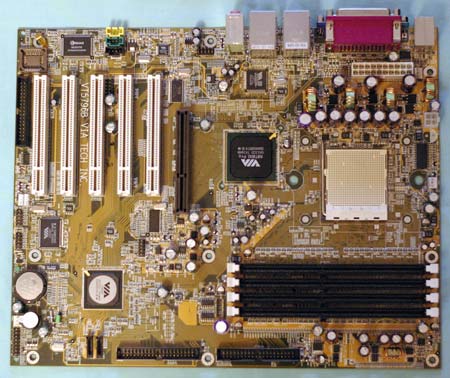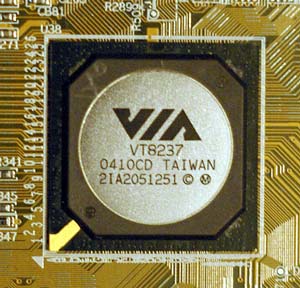VIA K8T800 PRO: PCI/AGP Lock and 1000 HyperTransport for Athlon 64
by Wesley Fink on May 6, 2004 5:00 AM EST- Posted in
- CPUs
Basic Features: VIA K8T800 PRO Reference Board
| Motherboard Specifications | |
| CPU Interface | Socket 940 Athlon 64 Athlon 64 FX and Opteron |
| Chipset | VIA K8T800 PRO/VIA VT8237 |
| HyperTransport | Auto, 1Ghz, 800MHz, 600, 400, 200 |
| Bus Speeds | 200MHz to 255MHz (in 1MHz increments) |
| PCI/AGP Speeds | Automatic, Async at 66.8 or 75.4 |
| Core Voltage | No Adjustments |
| DRAM Voltage | No Adjustments |
| AGP Voltage | No Adjustments |
| Memory Slots | Four 184-pin DDR DIMM Slots Dual-Channel Configuration Registered ECC/Non-ECC Memory to 4GB Total |
| Expansion Slots | 1 AGP 8X Slot 5 PCI Slots |
| Onboard Serial ATA RAID | VIA 8237 (2 Drives, 0, 1) |
| Onboard IDE | Two Standard VIA ATA133/100/66 (4 drives) |
| Onboard USB 2.0/IEEE-1394 | 8 USB 2.0 ports supported by 8237 No Firewire |
| Onboard LAN | VIA VT6122 Gigabit LAN 10/100 LAN by VIA 8237 |
| Onboard Audio | VIA VT1616 codec AC '97 2.3 6-Channel with UAJ |

As a Reference Board, there's not a lot to say about the board layout. Reference Boards are designed for testing and qualification and will not likely see production as a retail product. Having said that, VIA has done an outstanding job of including a full complement of features and VIA chip additions to demonstrate what the K8T800 PRO can do.

The K8T800 PRO Northbridge is the only real change in the PRO.

VIA continues to use the very competent 8237 Southbridge, which first brought the Athlon 64 feature set to Intel 865/875 levels.

The K8T800 PRO Reference Board was equipped with the VIA VT1616 Vinyl Six-Trac audio chip. The 1616 is the 18-bit junior member of the audio family. Manufacturers could also use the top-line Envy24 for a premium audio setup. The 1616 is cheaper, but still very capable, providing 6-channel audio that exceeds Microsoft's WHQL logo requirements. VIA provides detailed information on the Vinyl Six-Trac capabilities at the VIA web site.
"The VIA Six-TRAC is a complete solution supporting the AC'97 2.2 specification with S/PDIF extension compliance. Enabling 6 channel outputs with 18-bit resolution the VIA VT1616 can support full 5.1 surround sound enabling theatre-quality home audio systems. For optimum playback performance the Six-TRAC analog mixer circuitry integrates stereo enhancement to provide a pleasing 3Ds surround sound effect for stereo media. Further provisions in the hardware allow for downmixing of 6-channel inputs such as DVDs into 4-channel, or even 2-channels outputs.
An 18-bit independent rate stereo ADC enables 5 stereo and 2 mono analog line-level inputs allowing recording from sources such as microphones, CDs, line-ins etc. With sample rate converters on all channels the VIA Six-TRAC can be adjusted in 1Hz increments allowing exacting audio manipulation. To maintain full digital audio paths the VIA VT1616 has an IEC958 line driver for S/PDIF compressed digital or LPCM audio outputs."

Gigabit LAN is provided by another VIA chip - the VT6122. 10/100/1000Mb data transfer rates are supported, but this LAN solution is basically on the PCI bus, with the limitations of that arrangement. In real-world terms, this is not very significant today, but it will matter to some buyers. nVidia's on-chip gigabit LAN, by comparison, is completely removed from the speed limitations of the PCI bus. VIA's on-chip LAN is 10/100 Ethernet, and gigabit LAN is provided by an additional chip.

While this is a Reference Board, VIA has provided a complete complement of rear IO ports, including both 10/100 and Gigabit LAN. While IEEE1394 firewire is not a part of the K8T800 PRO chipset, VIA provides accessory chips for adding firewire capabilities to motherboards using the K8T800 PRO chipset.










15 Comments
View All Comments
Odeen - Saturday, May 8, 2004 - link
#4: The answer is pretty much a "yes"Reason: Firewire, in this design, sits on the PCI bus. Gigabit networking sits on the PCI bus. Any soundcard / chip better than chipset-provided onboard sound sits on the PCI bus. Any additional hard drive controllers sit on the PCI bus.
On non-server motherboards, the PCI bus runs at 33mhz and is 32 bits wide, for 133 megabytes/sec of bandwidth
Firewire is 400mbit/sec per port. The new design is 800mbit/sec. This means you will use a maximum of 50 megabytes/sec for a firewire/400 port (granted, the practical peak is less than 50mb/sec, but you'll never eke out 133mb/sec out of the PCI bus either). Add to that the 250mb/sec full-duplex Gigabit Ethernet can generate, and 150mb/sec for ever SATA port courtesy of those Silicon Image chips, and you can see that you're starved for bandwidth.
On the other hand, there's a tidy 533 megabytes/sec of bandwidth between the northbridge and the southbridge.. that means everything that runs straight off the southbridge can report back to the northbridge and, consequently, to the CPU at 533mb/sec. Subtract 133mb/sec for the PCI, and you still have 400 megabytes for LAN and hard drives and firewire, if it's implemented in the southbridge.
Unfortunately, the only true "onboard" firewire comes courtesy of the MCP-T southbridge on nForce2 boards. Everyone else (All Via, all SiS, all Intel chipsets, and all chipsets for Athlon64) has to use a PCI firewire chip.
Pumpkinierre - Friday, May 7, 2004 - link
Welsey #11, I would liked to have seen an 8or9 x 233and234. I still smell a rat. I've run some mobos at 41MHz PCI speed in the past while others (same brand and chipset but different review) would not function. The fact that other posts claim that ABIT have left out the AGP/PCI lock feature of this chipset adds to my suspicion.Klaasman - Friday, May 7, 2004 - link
Why oh why ABIT, would they leave this out?? Damn it!blup - Friday, May 7, 2004 - link
This board breaks my heart. I was hoping for a "BH7 for Athlon 64" i.e. cheap, fast, very overclockable. It is not to be.ABIT has NOT implemented the PCI/AGP lock on this board - maybe there will be a more expensive MAX model that does. Checkout one man's review at http://www.nickgoodall.org/kv8pro/review1.htm
Wesley Fink - Friday, May 7, 2004 - link
#10 -I did a quick check with PC Geiger and the bus was locked on the Reference Board. Since I had the board for only 2 days for testing, there was no time for much more. You will also see I reached 231 overclock on the FX51 at 10 ratio, in addition to the 255x8.
Checking my review notes, I also tested the 10 multiplier at 233 and 234 to determine if there was a ratio drop. I could boot at 233 but the system wasn't completely stable; the CPU simply would not do 234 at standard multiplier. This also suggests a working lock.
Please also keep in mind that VIA has a working pci/agp lock on the PT880 chipset for the P4, so this is not their first PCI/AGP lock. It is just their first lock on an Athlon 64 chipset.
Pumpkinierre - Thursday, May 6, 2004 - link
You got to 8x252 on the Aopen AK86-L (VIA chipset/Skt754) which didnt have PCI/AGP lock but ratio controlled. Given its an a64/FX chipset (and on top VIA) where AGP/PCI lock has been a matter of controversy, would'nt it have been prudent to have used your PCIgeiger to check the PCI frequencies at the different FSB settings-so that we wont be fooled once again!Jeff7181 - Thursday, May 6, 2004 - link
This is definately a good thing... finally overclockers have a choice between chipsets.Warder45 - Thursday, May 6, 2004 - link
I thought the Pro was going to have a HT speed of 1200?Wesley Fink - Thursday, May 6, 2004 - link
#6 -PCI/AGP lock is DEFINITELY working on the Reference Board, but I can not yet address whether Abit has implemented the lock or just dropped the PRO chipset in the older design with no changes. I did see the one review in the UK reporting this issue before the VIA review was finished.
We do have the Abit board coming to us for testing and I will report what I find.
Klaasman - Thursday, May 6, 2004 - link
Abit has a board out now but reports are that it does NOT have the AGP/PCI lock working.